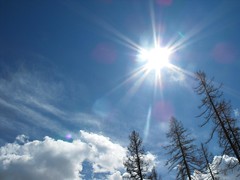This AP biology exam review covers energy, thermodynamics, metabolism, photosynthesis, and cellular respiration.
| 5551717019 | Energy | the ability to cause change; ability to do work | 0 | |
| 5551717020 | First law of thermodynamics | energy cannot be created or destroyed, but it can be converted from one form to another | 1 | |
| 5551717021 | Second law of thermodynamics | any time energy is converted the entropy (disorder) of the universe increases | 2 | |
| 5551717022 | Gibbs free energy | energy in a system that is available to do work | 3 | |
| 5551717023 | Exergonic | Chemical reactions that release energy | 4 | |
| 5551717024 | Endergonic | A chemical reaction that requires the input of energy in order to proceed. | 5 | |
| 5551717025 | ATP | molecule made in cellular respiration; functions as the cell's energy currency (adenosine triphosphate) |  | 6 |
| 5551717026 | Metabolic pathway | a series of enzymes-catalyzed reactions in which the product of one is the reactant of another |  | 7 |
| 5551717027 | Catabolism | metabolic pathway that breaks down substances and releases energy | 8 | |
| 5551717028 | Anabolism | metabolic pathway that builds substances and stores energy | 9 | |
| 5551717031 | Photoautotrophs | autotrophs that make their own food from the sun |  | 10 |
| 5551717034 | Photosynthesis | A process used by plants and other autotrophs to capture light and energy and use it to power chemical reactions that convert carbon dioxide and water into oxygen and energy-rich carbohydrates, such as sugars and starches. | 11 | |
| 5551717042 | Photosystem | A cluster of pigments embedded into a thylakoid membrane. | 12 | |
| 5551717043 | Chemiosmosis | Process in which energy stored in the form of a hydrogen ion gradient across a membrane is used to drive cellular work, notably synthesis of ATP. | 13 | |
| 5551717045 | Cellular respiration | Process that releases energy by breaking down glucose and other food molecules in the presence of oxygen | 14 | |
| 5551717049 | Redox reaction | Oxidation (an atom loses electrons) and reduction (an atom gains electrons) reactions | 15 | |
| 5551717052 | Oxidative phosphorylation | The oxidation electron carriers (NADH and FADH2) coupled to the phosphorylation of ADP, producing ATP. In eukaryotes, this process occurs in the mitochondira. | 16 | |
| 5551754415 | Competitive inhibition | form of enzyme inhibition where binding of the inhibitor is on the active site on the enzyme prevents binding of the substrate | 17 | |
| 5551762139 | Noncompetitive inhibition | inhibitor binds to the allosteric site on the enzyme; alters active site so that the substrate cannot bind | 18 | |
| 5551790647 | Induced fit | The change in shape of the active site of an enzyme so that it binds more snugly to the substrate, induced by entry of the substrate. | 19 | |
| 5551796786 | Conformational change | a slight change in the three dimensional structure of a protein that may result in a change in activity | 20 | |
| 5551804424 | Activation energy | Energy needed to get a reaction started | 21 | |
| 5551815768 | photorespiration | A metabolic pathway that consumes oxygen, releases carbon dioxide, generates no ATP, and decreases photosynthetic output; generally occurs on hot, dry, bright days, when stomata close and the oxygen concentration in the leaf exceeds that of carbon dioxide. | 22 | |
| 5551823399 | Aerobic | Process that requires oxygen | 23 | |
| 5551823400 | Anaerobic | Process that does not require oxygen. | 24 | |
| 5551867539 | Noncyclic electron flow | A route of electron flow during the light reactions of photosynthesis that involves both photosystems and produces ATP, NADPH, and oxygen. The net electron flow is from water to NADP+. | 25 | |
| 5551877470 | Cyclic electron flow | A route of electron flow during the light reactions of photosynthesis that involves only photosystem I and that produces ATP but not NADPH or oxygen | 26 | |
| 5551887585 | Electron transport chain | Series of chemical reactions in the thylakoid membrane or inner mitochondrial membrane during which hydrogens or their electrons are passed along with the release of energy | 27 | |
| 5551895622 | Carbon fixation | The process by which carbon from an inorganic source (such as carbon dioxide) gets incorporated into an organic molecule (such as glucose). | 28 | |
| 5551913762 | Pyruvate oxidation | pyruvate is shuttled to the inner mitochondrial matrix -converted to Acetyl CoA | 29 | |
| 10840775765 | CAM plants | plants close their stomata during the day, collect CO2 at night, and store the CO2 in the form of acids until it is needed during the day for photosynthesis | 30 | |
| 10840780385 | C4 plants | A plant that prefaces the Calvin cycle with reactions that incorporate CO2 into four-carbon compounds, the end product of which supplies CO2 for the Calvin cycle. | 31 | |
| 10840780386 | C3 plants | A plant that uses the Calvin cycle for the initial steps that incorporate CO2 into organic material, forming a three-carbon compound as the first stable intermediate. | 32 |

